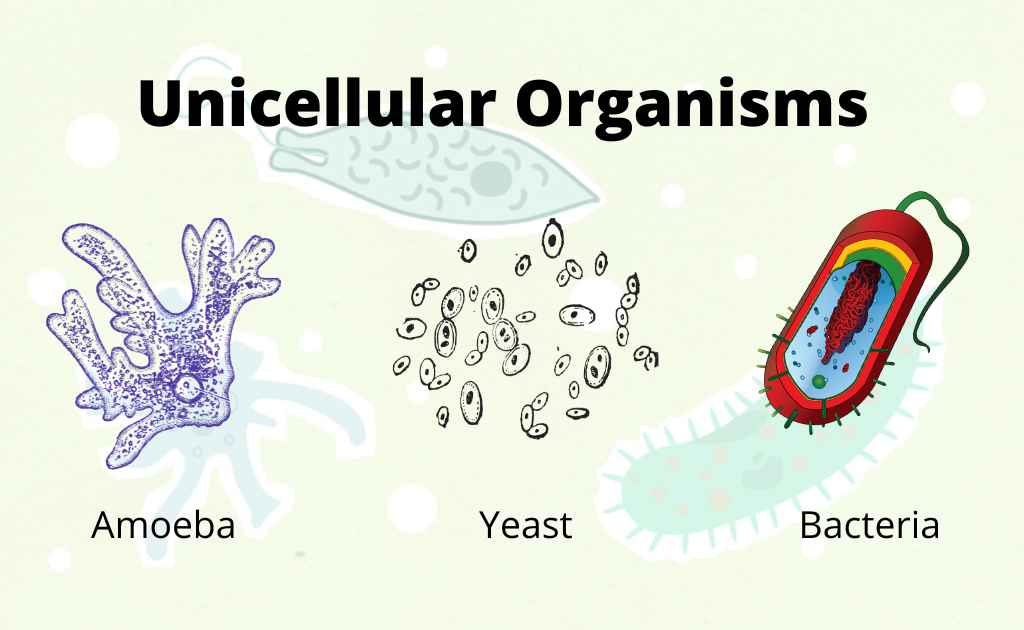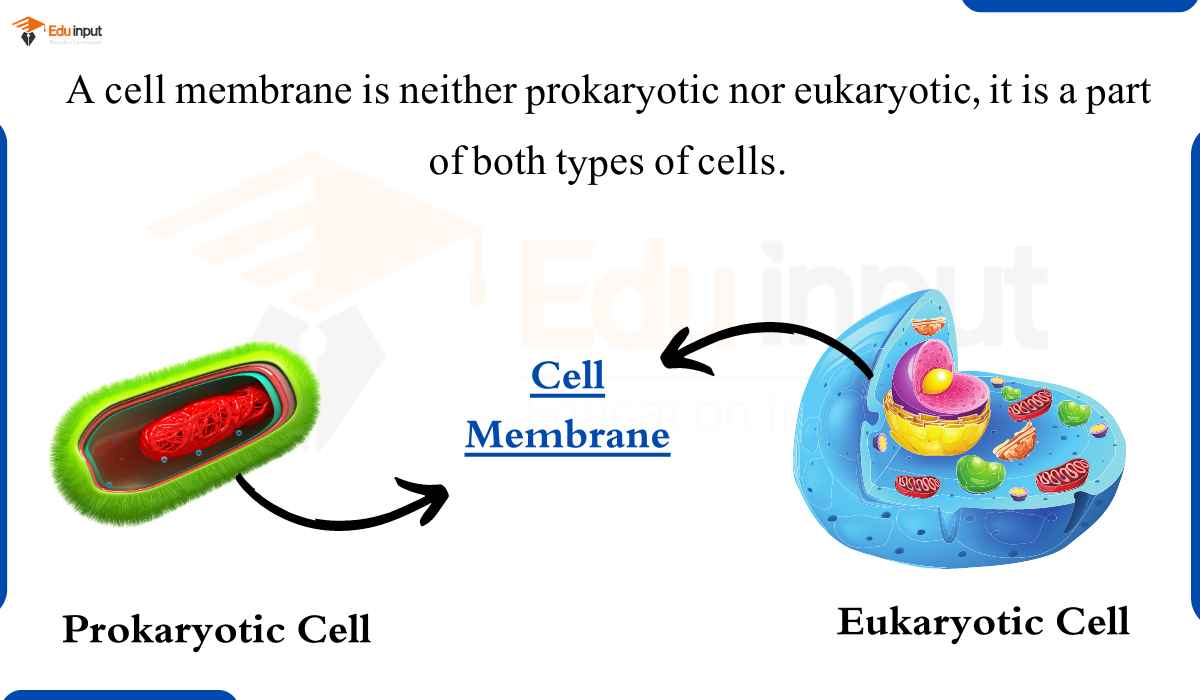Unicellular Organisms – Characteristics, Physiology, Cell Organization, Classification
What are Unicellular Organisms?
Unicellular organisms are living organisms that are composed of a single cell. They are the most basic and fundamental forms of life.
Some of the common unicellular organisms are bacteria, fungi, algae, Yeast, Euglena, Paramecium, and Amoeba.

Analogy for Unicellular Organisms
Unicellular organisms are like tiny self-contained cities, where a single cell performs all the necessary functions for life within its boundaries, just as a city provides for its residents’ needs through various departments and infrastructure.
Characteristics of Unicellular Organisms
Here are the main Characteristics of Unicellular Organisms:
- They are microscopic in size and can only be observed through a microscope.
- They are composed of a single cell that carries out all the essential functions necessary for life, such as metabolism, response to stimuli, growth, and reproduction.
- They lack specialized tissues or organs, as all the cellular components are contained within a single cell membrane.
- They can be either prokaryotic (lacking a true nucleus and membrane-bound organelles) or eukaryotic (possessing a true nucleus and membrane-bound organelles).
- They can vary in shapes, sizes, and cellular organizations. It depends on their taxonomic group and adaptations to various environments.
- They are found in diverse habitats, including aquatic environments, soil, air, and even within other living organisms as symbionts or parasites.
Cell Organization of Unicellular Organisms
The organization of cells in unicellular organisms is not complicated as the cells have similar features in terms of shape, size, and function. A single cell can be divided into several parts in a unicellular organism. The function of each part is different and a group of cells can communicate with one another to perform a particular function.
Unicellular organisms exhibit different levels of cellular organization:
Cell Organization of Prokaryotic Unicellular Organisms (Bacteria and Archaea)
Here is the Cell organization of Prokaryotic unicellular organisms:
- Prokaryotes are the simplest unicellular organisms and lack a true nucleus and membrane-bound organelles.
- They have a single circular chromosome (genetic material) located in the cytoplasm.
- Some prokaryotes may also possess smaller circular DNA molecules called plasmids.
- The cytoplasm is enclosed by a cell membrane and a cell wall (made of peptidoglycan in bacteria and various other compounds in archaea).
- Certain prokaryotes may have additional structures like flagella for motility, pili for attachment, and inclusions like gas vacuoles or storage granules.
Cell Organization of Eukaryotic Unicellular Organisms (Protists, Unicellular Algae, and Unicellular Fungi)
Cell organization of Eukaryotic unicellular organisms is a bit more complex than prokaryotic unicellular organisms:
- Eukaryotic unicellular organisms have a more complex cellular organization compared to prokaryotes.
- They possess a true nucleus, which is surrounded by a double membrane called the nuclear envelope and contains the genetic material (DNA).
- The cytoplasm of eukaryotic cells contains various membrane-bound organelles, such as mitochondria (for energy production), endoplasmic reticulum (for protein synthesis and transport), Golgi apparatus (for packaging and sorting proteins), and vacuoles (for storage and digestion).
- Some eukaryotic unicellular organisms may have additional structures like chloroplasts (for photosynthesis in algae), flagella or cilia for motility, and a cytoskeleton made up of microtubules and microfilaments for structural support and cellular transport.
- The cell is surrounded by a plasma membrane, and some eukaryotic unicellular organisms may have additional protective structures like cell walls (e.g., in some algae and fungi).
Classification Of Unicellular Organisms
Unicellular organisms are classified into several broad categories based on their characteristics and evolutionary relationships. Here’s an overview of the classification of unicellular organisms:
Prokaryotes
Prokaryotes are unicellular organisms, that are devided into two categories:
1. Bacteria
These are single-celled organisms that lack a true nucleus and membrane-bound organelles. Bacteria are further classified into different phyla based on their characteristics, such as cell wall composition, shape, and metabolic processes.
2. Archaea
These are single-celled organisms that are distinct from bacteria and eukaryotes. Archaea are found in extreme environments, such as hot springs, salt lakes, and deep-sea hydrothermal vents.
Eukaryotes
Many eukaryotes are unicellular organisms. Here are some of them:
1. Protists
These are single-celled eukaryotic organisms that are not plants, animals, or fungi. Protists are a diverse group and are classified into various phyla based on their characteristics, such as mode of locomotion, presence or absence of cell walls, and methods of reproduction. Some examples of protist phyla include Amoebozoa, Ciliophora, and Euglenozoa.
2. Unicellular fungi
These are single-celled fungi, such as yeasts, that belong to the kingdom Fungi.
3. Unicellular algae
These are single-celled photosynthetic organisms that belong to different phyla, such as Chlorophyta (green algae) and Bacillariophyta (diatoms).
Nutrition In Unicellular Organisms
The mode of nutrition adopted by a unicellular organism is influenced by various factors, such as the availability of nutrients in the environment, metabolic capabilities of organism, and evolutionary adaptations.
Unicellular organisms uses various modes of nutrition to obtain energy and nutrients for their survival and growth. There are four main modes of nutrition in unicellular organisms:
1. Autotrophic nutrition
Some unicellular organisms can make their own food:
- Photoautotrophs – These organisms, such as unicellular algae and certain bacteria, can synthesize their own organic compounds from carbon dioxide and water using energy from sunlight through the process of photosynthesis.
- Chemoautotrophs – These organisms, such as certain bacteria and archaea, obtain energy from the oxidation of inorganic compounds like ammonia, nitrites, hydrogen sulfide, or ferrous iron. They use this energy to convert carbon dioxide into organic compounds.
2. Heterotrophic nutrition
Unicellular Organisms are devided into following categories based on their Heterotrophic mode of nutrition:
- Saprotrophs – These organisms, such as certain fungi and bacteria, obtain nutrients by decomposing and absorbing organic matter from dead or decaying organisms and their by-products.
- Parasites – These organisms, like certain protists and bacteria, live on or within a host organism and derive nutrients from the host, often causing harm to the host.
- Predators – Some unicellular organisms, such as certain protists, actively prey on other smaller unicellular organisms for nutrients.
3. Mixotrophic nutrition
Certain unicellular organisms, like some algae and protists, can employ both autotrophic and heterotrophic modes of nutrition, depending on the availability of resources in their environment.
4. Symbiotic nutrition
Some unicellular organisms engage in symbiotic relationships with other organisms, where they exchange nutrients or provide other benefits to their host or partner organism.
Reproduction In Unicellular Organisms
Unicellular organisms employ various modes of reproduction, both asexual and sexual for their survival and propagation. Here are the common modes of reproduction observed in unicellular organisms –
Asexual Reproduction
Unicellular organisms use following methods of asexual reproduction –
- Binary fission – This is the most common mode of asexual reproduction in prokaryotes (bacteria and archaea). The parent cell divides into two equal-sized daughter cells through the division of the cytoplasm and the replication of genetic material.
- Budding – In this process, observed in some unicellular eukaryotes like yeasts, a small outgrowth or bud forms on the parent cell, which eventually detaches and develops into a new individual.
- Fragmentation – Some unicellular organisms, like certain algae and protists, can break into fragments, and each fragment can develop into a new individual.
- Spore formation – Many unicellular organisms, including bacteria, fungi, and protists, can form spores under specific environmental conditions. These spores are resistant to harsh conditions and can germinate to produce new individuals when conditions become favorable.
Sexual Reproduction
Unicellular organisms also reproduce by sexual reproduction. Here are a few modes of sexual reproduction that they use:
- Conjugation – This mode of sexual reproduction is observed in some bacteria and protists. It involves the temporary fusion of two parent cells, during which genetic material is exchanged, leading to the formation of recombinant offspring.
- Syngamy – In this process, two gametes (reproductive cells) fuse to form a zygote, which then develops into a new individual. This mode of sexual reproduction is observed in some protists and unicellular algae.
- Meiosis – Some unicellular eukaryotes, like certain protists and unicellular algae, can undergo meiosis, a specialized type of cell division that produces haploid gametes, which can then fuse to form a diploid zygote.

Respiration In Unicellular Organisms
Unicellular organisms exhibit various modes of respiration to obtain energy from organic compounds. Aerobic respiration is common in many unicellular eukaryotes and some bacteria. Anaerobic respiration is used by certain bacteria and archaea.
However, they use alternative electron acceptors like nitrates, sulfates, or organic compounds. Some unicellular organisms like yeasts use fermentation. In fermentation, they partially break down organic compounds without an external electron acceptor.
The mode of respiration depends on the organism’s metabolic capabilities and environmental conditions.
Importance Of Unicellular Organisms
Unicellular organisms are very important to society because they play a vital role in recycling. They recycle the nutrients that the plant needs. When the plant gets nutrients it makes the plant grow. The most important thing is that they keep the environment clean. It is the best way to keep the environment clean.
FAQs
Where are unicellular organisms found?
Unicellular organisms can be found almost everywhere on Earth

 written by
written by 





Leave a Reply